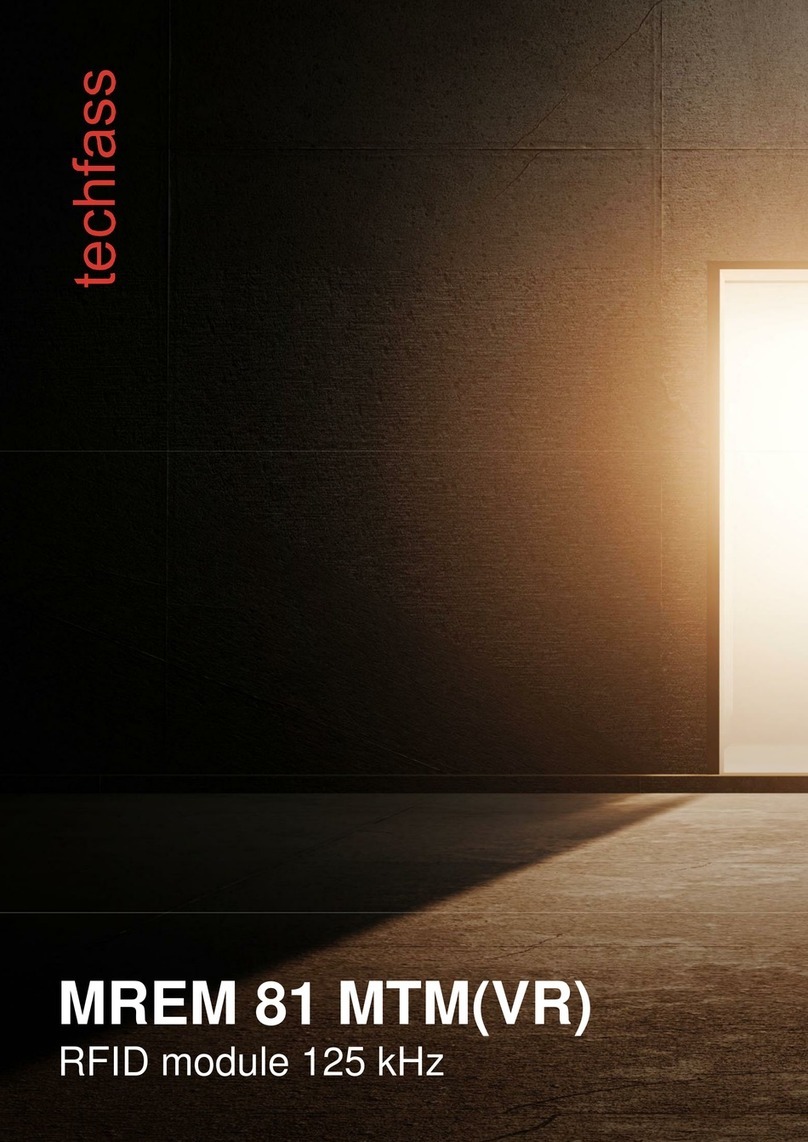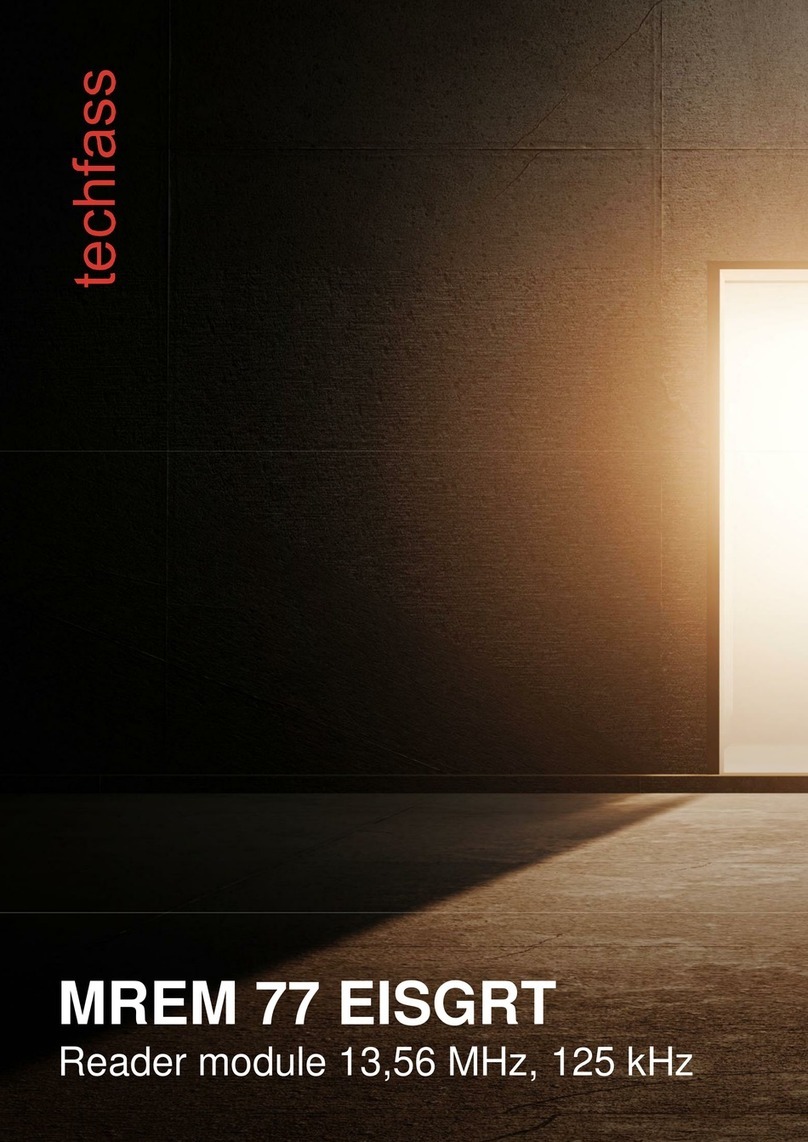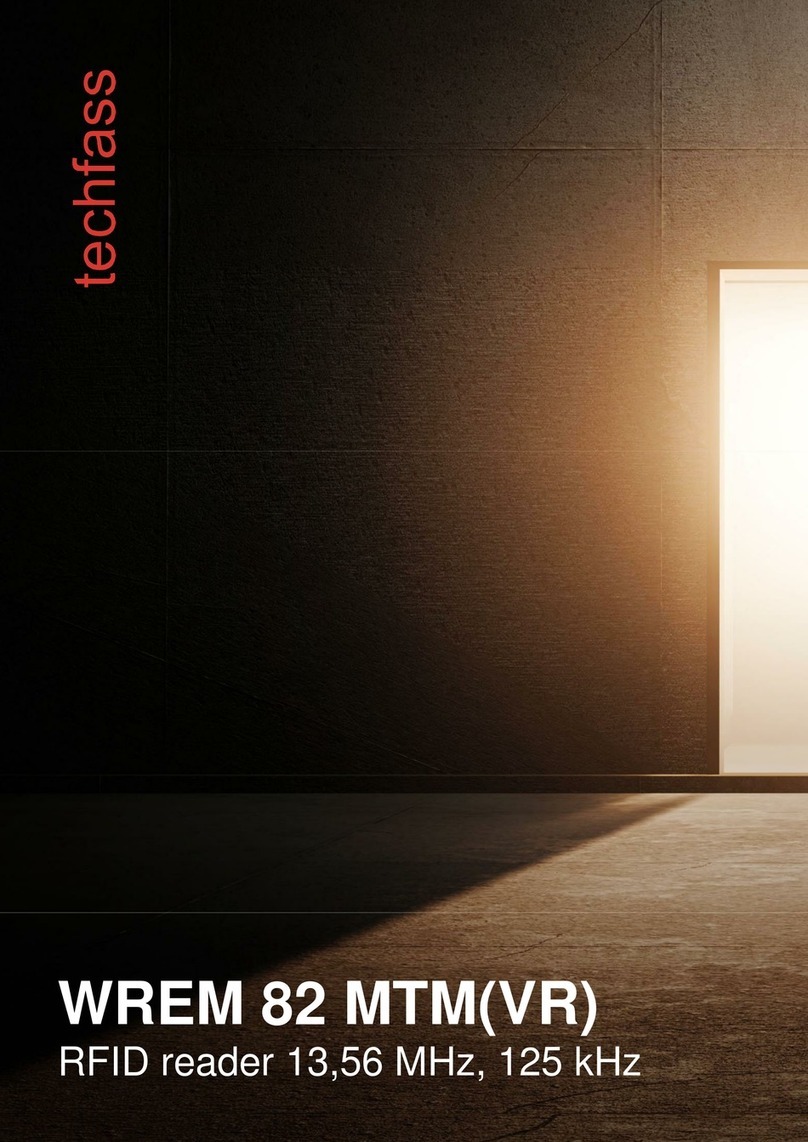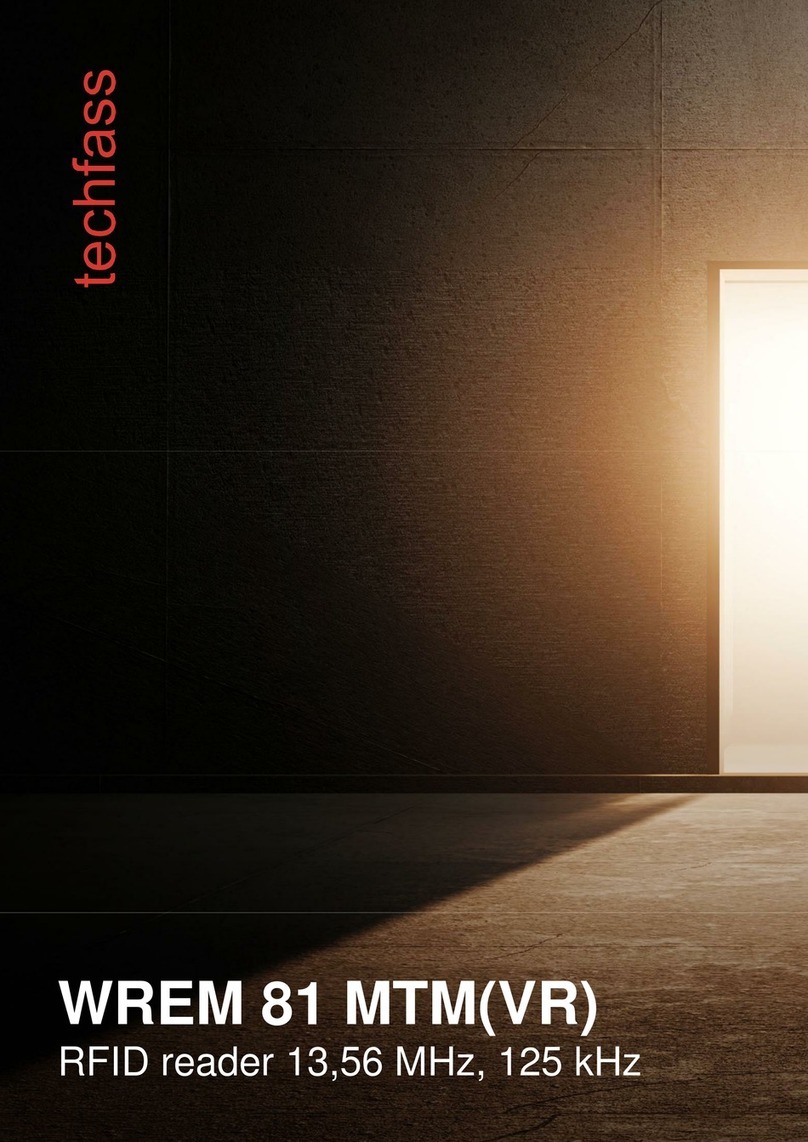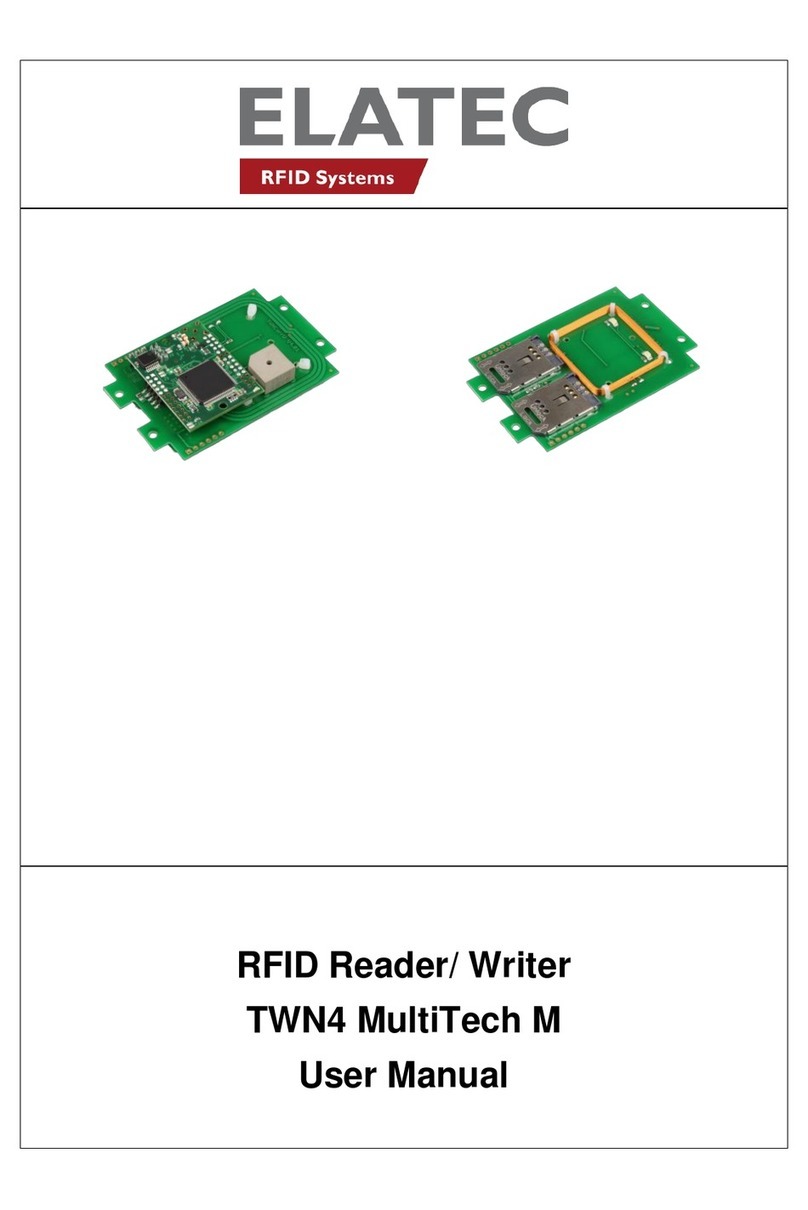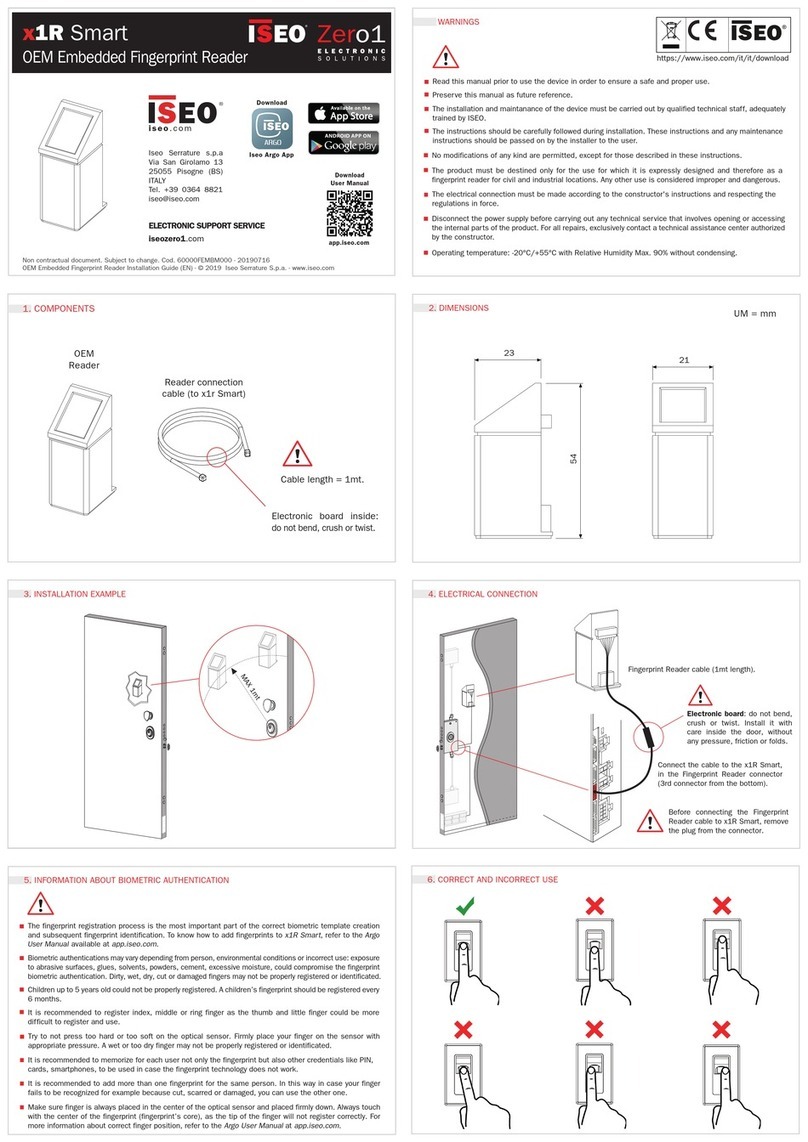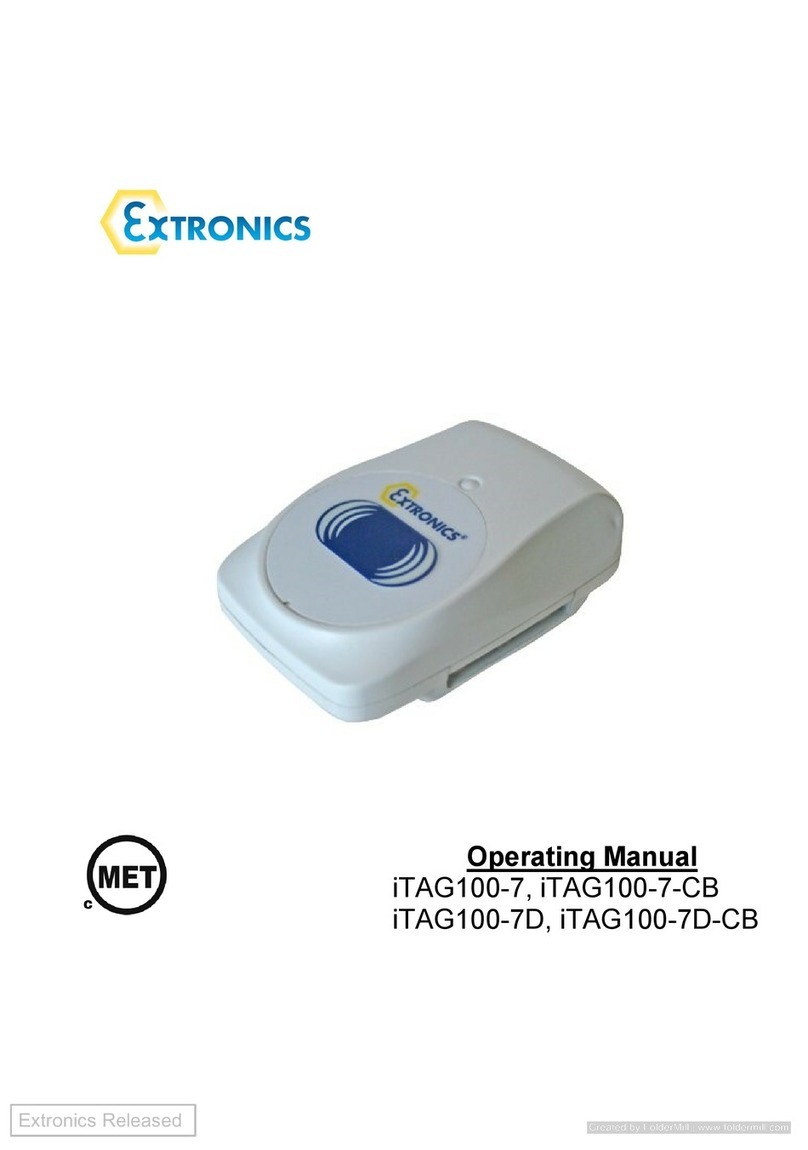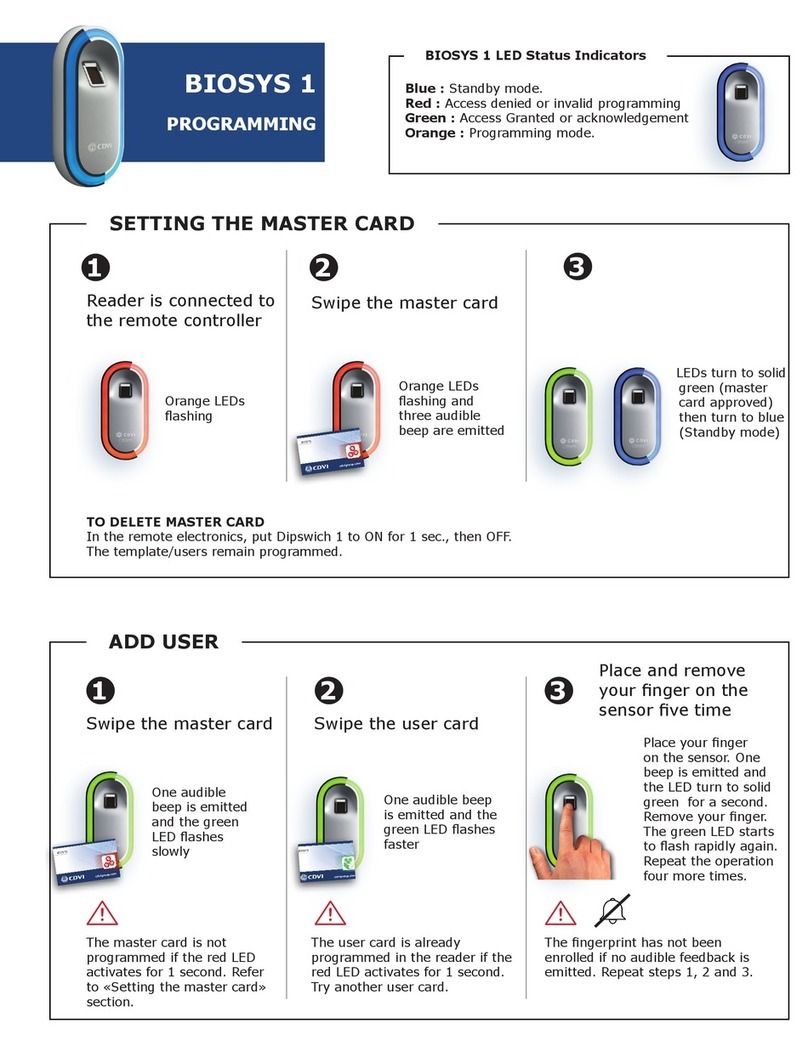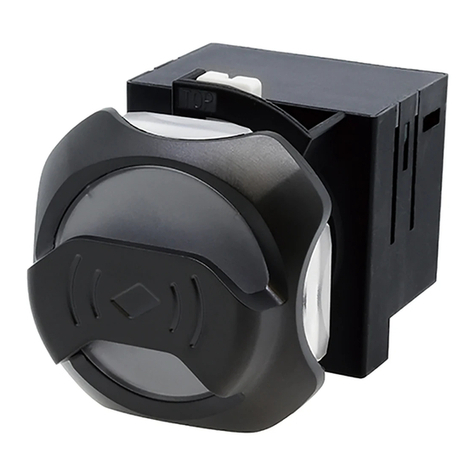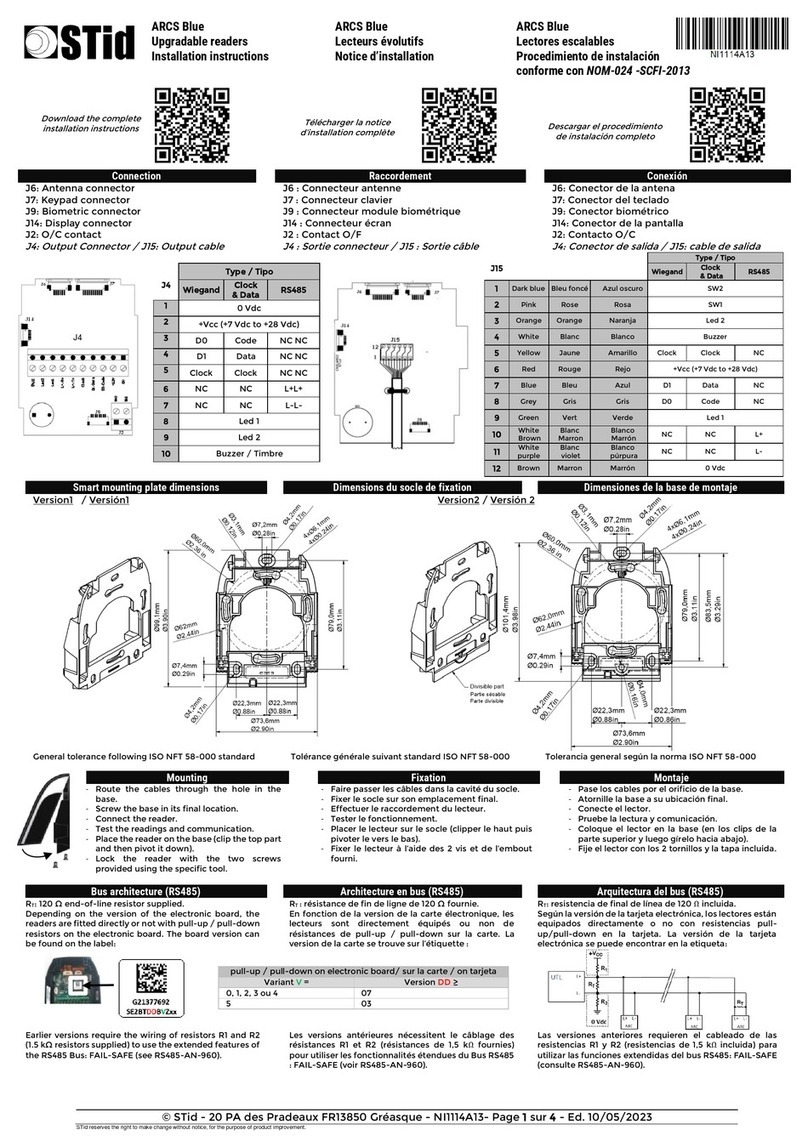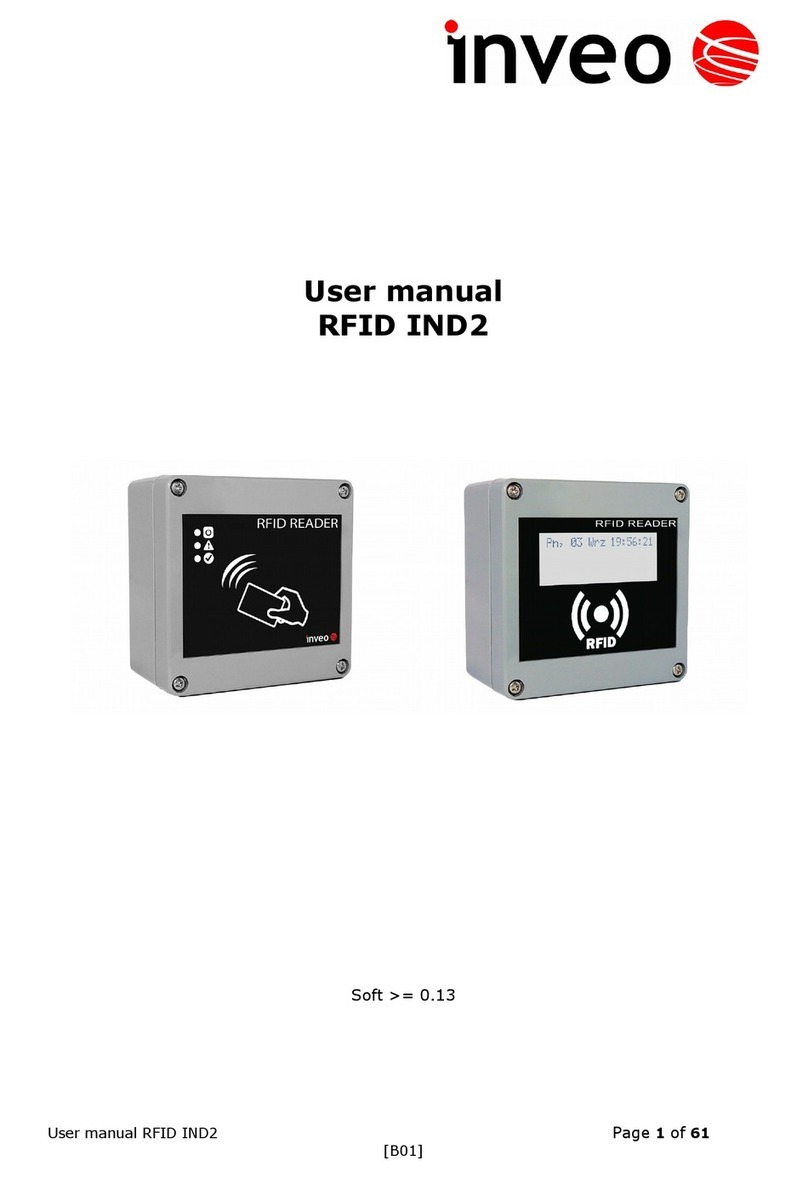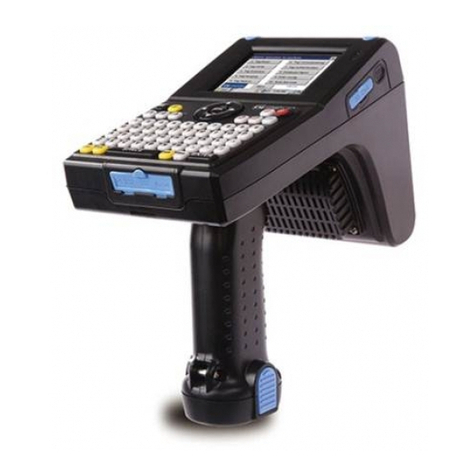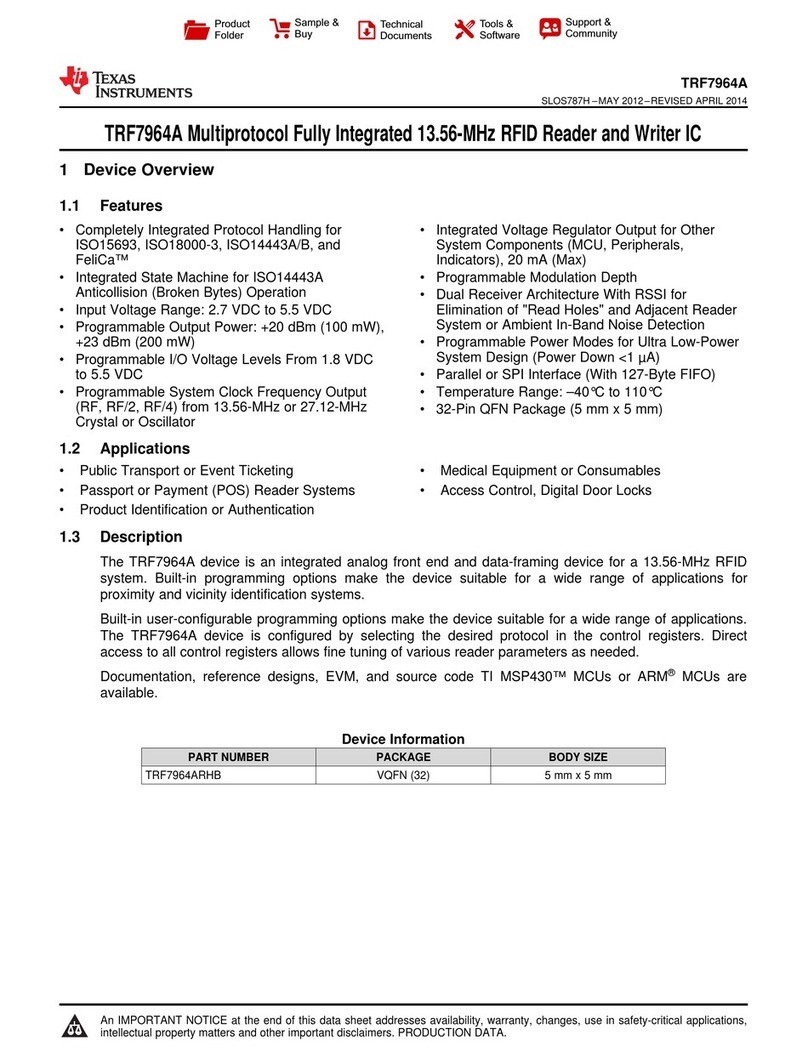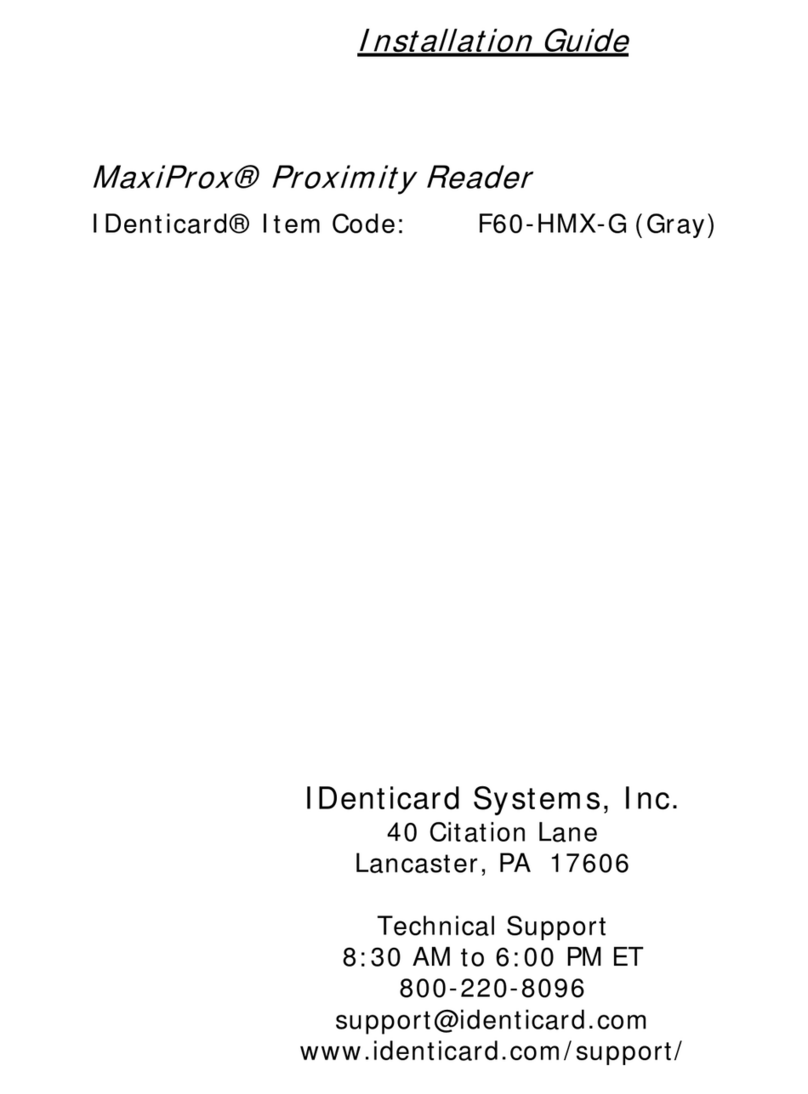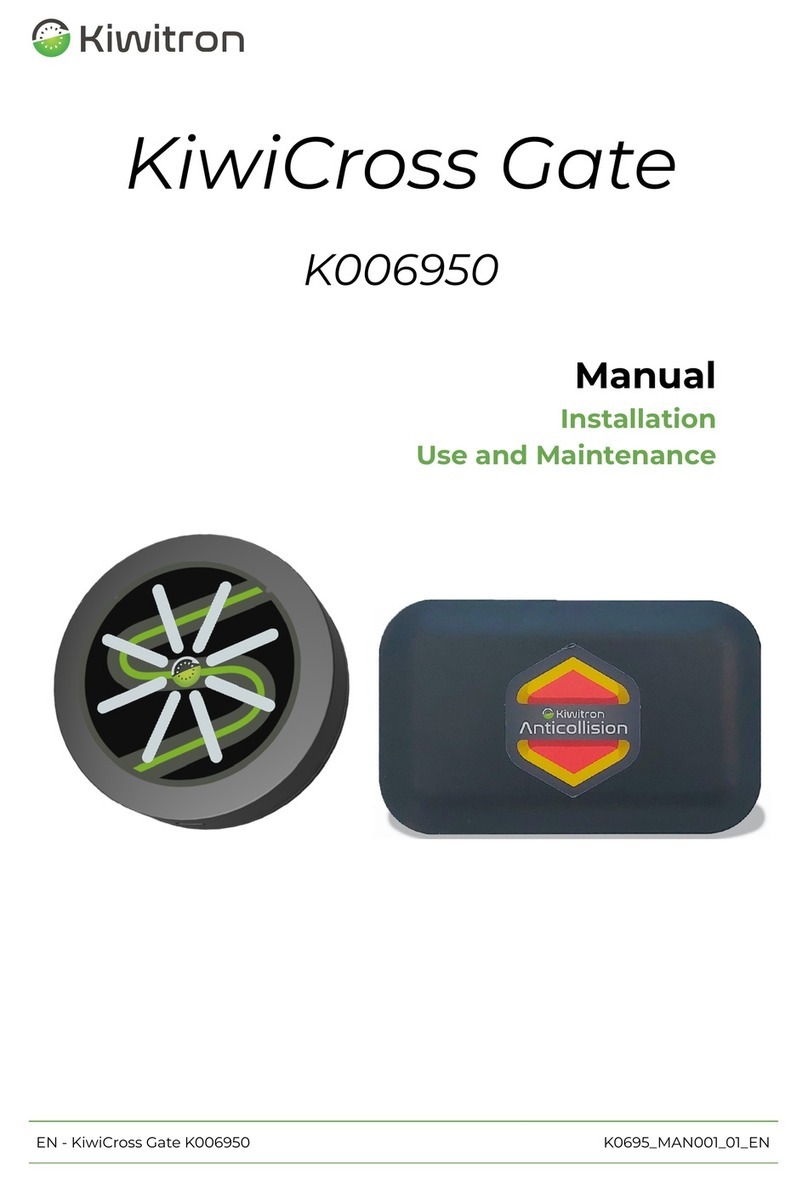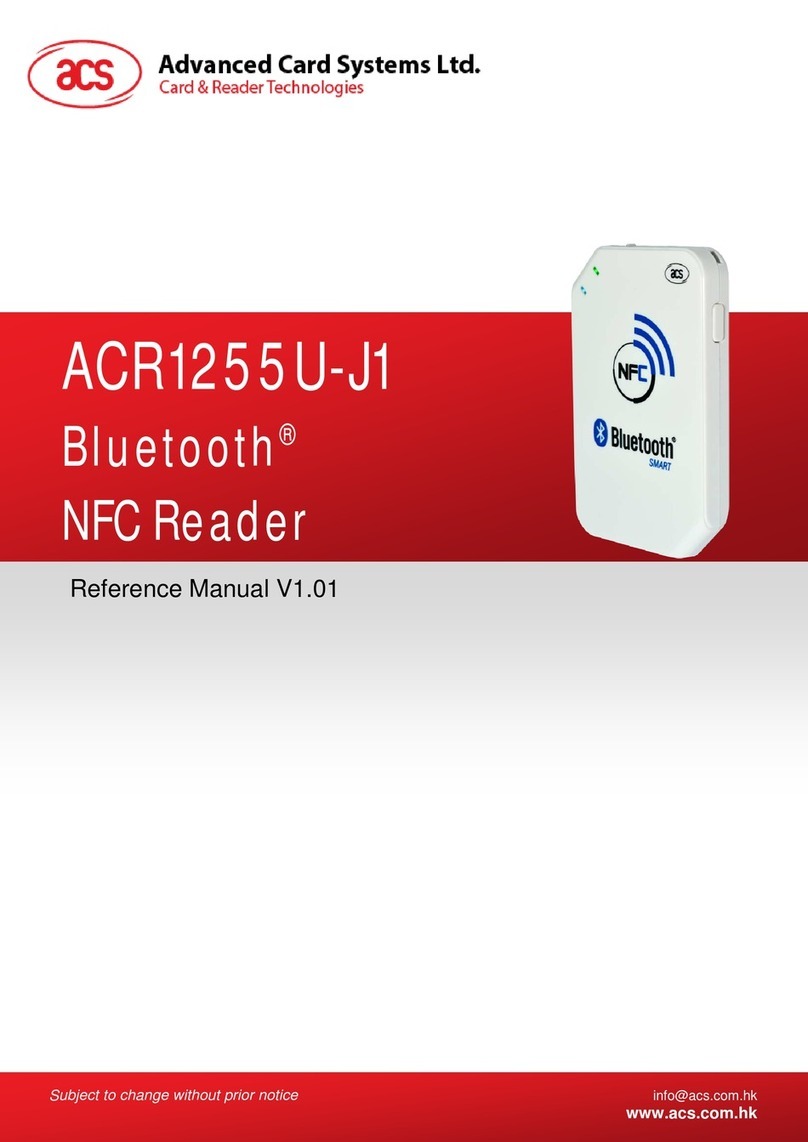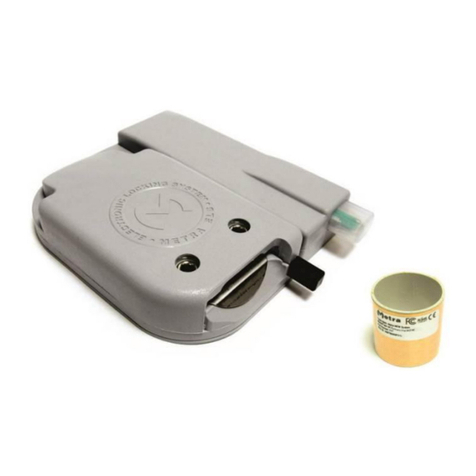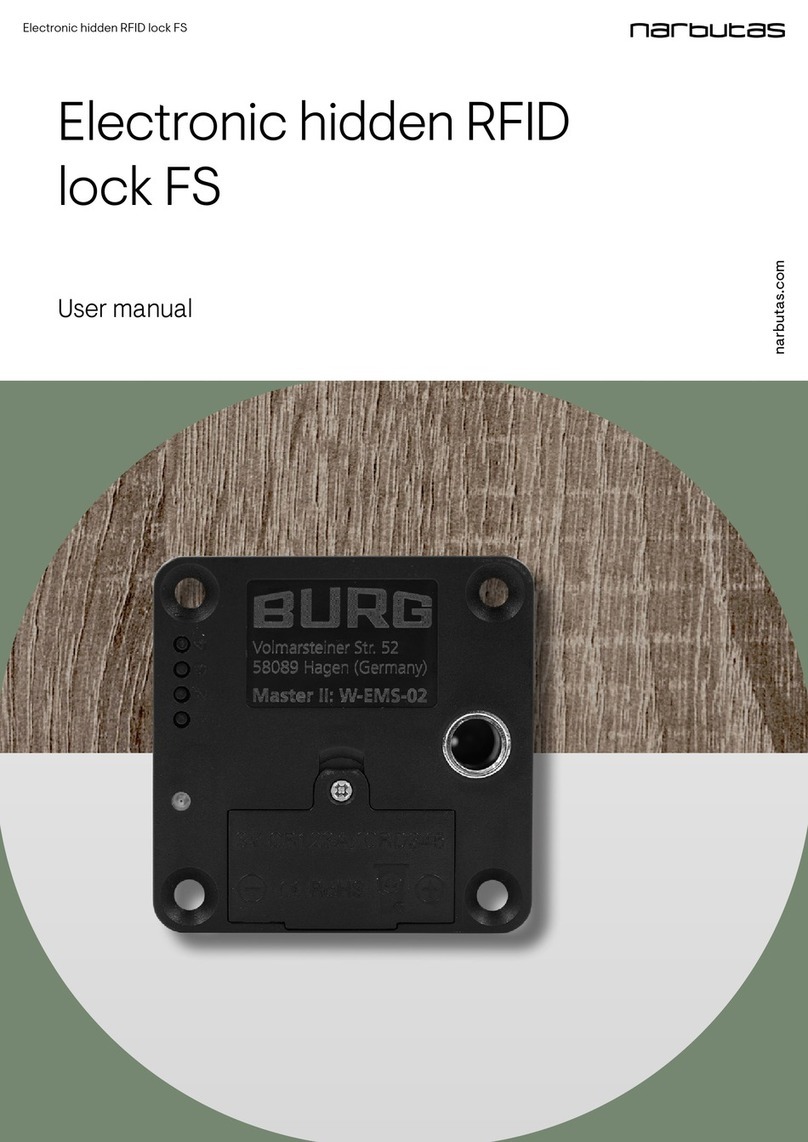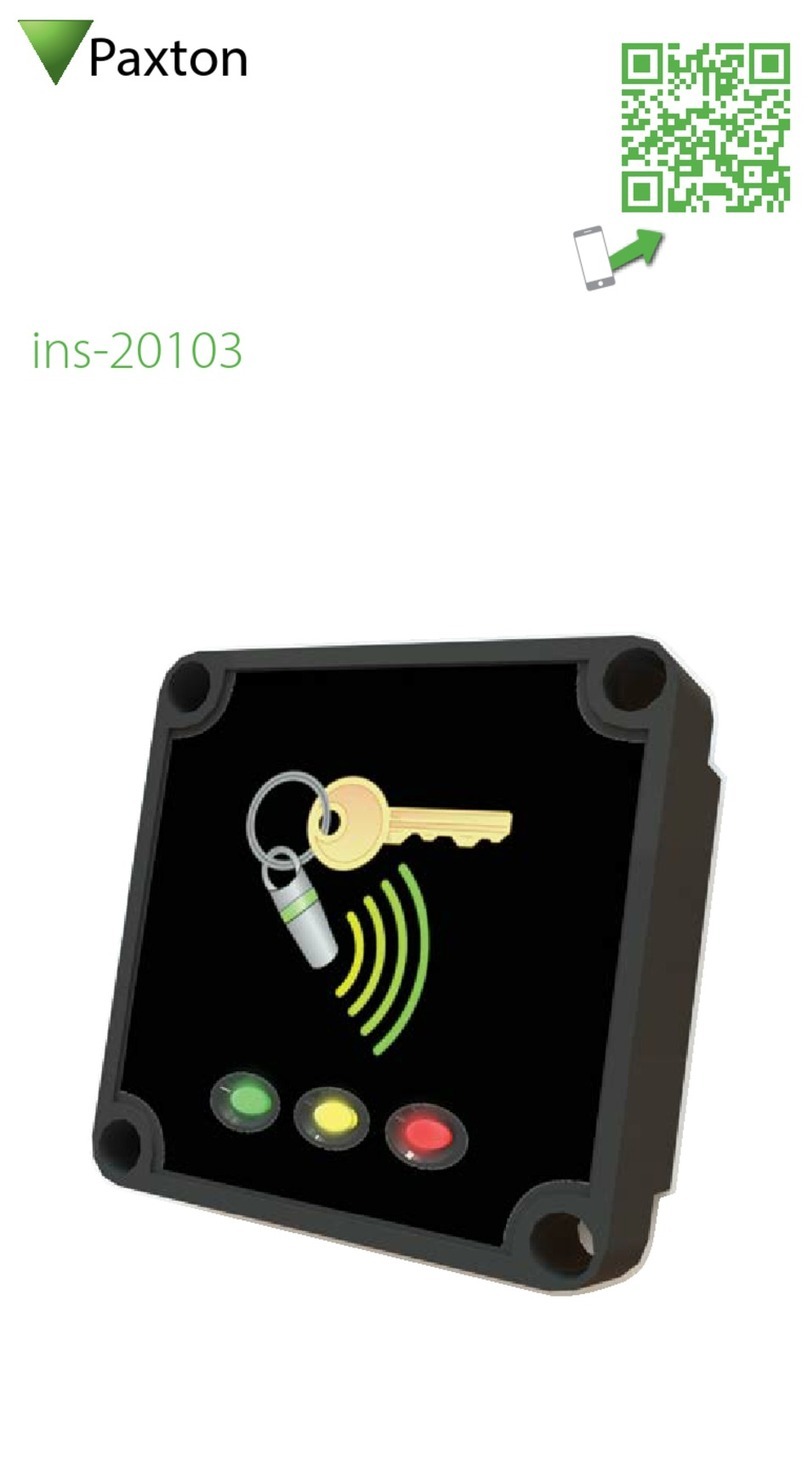TECH FASS MREM 82 NOGBKP User manual

MREM 82 NOGBKP
RFID module 13,56 MHz, 125 kHz

Introduction
RFID reader module MREM 82 NOGBKP (13.56 MHz reader / dual reader 13.56 MHz
and 125 kHz) with integrated controller for one door control is designed either for
connection to the RS 485 bus of the APS mini Plus access system or for autonomous
operation. The module is also equipped with a Wiegand interface for connecting an
input RFID reader with a Wiegand output for possible both-sided controlled door. Up to
32 MREM 82 reader modules can be connected to one RS 485 communication line of
the APS mini Plus system. The module is wall mounted with 2 m pig tail cable.
a. Application
▪Access control system, booking system
▪Door access control, both-sided access control
▪Lift access control
b. Parameters
▪Input voltage 8 ÷ 28 Vdc
▪Typical current consumption 53 mA @ 12 V
▪Maximum input power 1,1 W
▪Reading id media MIFARE®, NFC, EM Marin, Jablotron
▪1x RS 485 (system bus APS mini Plus)
▪1x Wiegand (external RFID reader, GSM module, license plate camera) or next RS 485 (OEM)
▪1x Open drain transistor output 60 V / 2 A
▪2x INPUT (door contact, exit button, tamper)
▪1x Alert output (Alert notification)
▪Wall mounted, pig tail cable 2 m
c. Variants
Outdoor (NOGBKP)
KATALOGUE NUMBER
PART NUMBER
SYSTEM
VARIANT
RFID frequency
534821E2
MREM 82 NOGBKP - MF
APS mini Plus
Wall mounted
13,56 MHz
53482203
MREM 82 NOGBKP
APS mini Plus
Wall mounted
125 kHz, 13,56 MHz
534821F1
MREM 82 NOGBKP - EM
APS mini Plus
Wall mounted
125 kHz
Indoor (NIGBKP)
KATALOGUE NUMBER
PART NUMBER
SYSTEM
VARIANT
RFID frequency
53482252
MREM 82 NIGBKP - MF
APS mini Plus
Wall mounted
13,56 MHz
53482233
MREM 82 NIGBKP
APS mini Plus
Wall mounted
125 kHz, 13,56 MHz
53482241
MREM 82 NIGBKP - EM
APS mini Plus
Wall mounted
125 kHz
d. Marking
MIFARE®a MIFARE Classic®are registered trademarks owned by NXP B.V.
Android®is registered trademark owned by Google LLC.

e. Block diagram
▪Complete door control; lock control (open drain), door contact input, exit button, alert output to PC or cloud,
wiegand input, system bus, power supply. The reader module can operate autonomously or as a part of the
system.
▪Connection on the RS 485 bus with control from a mobile phone from the WebHit cloud application. Up to 32
reader modules can be connected to one APS mini Plus line.
•How to connect in ‘‘star‘‘? Using the REP 485 line repeater.

Content
1Technical parameters...............................................................................................5
1.1 Electrical parameters..................................................................................................5
1.2 Communication interface............................................................................................5
1.3 Mechanical parameters ..............................................................................................5
2Assembly...................................................................................................................6
2.1 Cable connection of MREM 82 NOGBKP, NIGBKP...................................................6
2.2 System bus.................................................................................................................6
2.3 Assembly....................................................................................................................7
3RFID reading .............................................................................................................9
3.1 Reading at 13,56 MHz................................................................................................9
3.2 Reading at 125 kHz..................................................................................................10
3.3 Duální čtení na frekvenci 13,56 MHz &125 kHz .......................................................10
4Wiring diagram ......................................................................................................11
4.1 Connection possibilities MREM 82 NOGBKP...........................................................11
5Settings ...................................................................................................................13
5.1 Setup procedure.......................................................................................................13
5.2 HW address setting ..................................................................................................13
5.3 Meaning of LED indicators .......................................................................................14
5.4 Configurable parameters..........................................................................................15
6Operating modes....................................................................................................16
6.1 Standard operating mode.........................................................................................16
6.2 External reader with Wiegand output .......................................................................17
7Function ..................................................................................................................18
7.1 Functions of the reader module................................................................................18
7.2 Function ‘‘Door open‘‘...............................................................................................18
7.3 Permanent lock release based on valid time schedule ............................................18
7.4 Function of ID with flag.............................................................................................18
7.5 ID expiration .............................................................................................................19
7.6 Antipassback function (APB)....................................................................................19
7.7Disabling the reader module.....................................................................................19
7.8 Alerts and their signaling..........................................................................................19
7.9 Simplified access rights model .................................................................................21
7.10 Offline setting (programming) mode.........................................................................21
8Other........................................................................................................................25
8.1 Legislation ................................................................................................................25
8.2 Declaration of conformity..........................................................................................25
8.3 Electrical waste.........................................................................................................25

www.techfass.com RFID reader module MREM 82 NOGBKP, NIGBKP 5
1Technical parameters
1.1 Electrical parameters
PARAMETER
CONDITION
MIN
MAX
UNIT
Input voltage Vin
8
28
V
Typical current
consumption Iin
Vin = 8 V
Vin = 12 V
Vin = 24 V
75
53
30
mA
mA
mA
Peak current
consumption Iin
Vin = 8 V
Vin = 12 V
Vin = 24 V
106
73
42
mA
mA
mA
Typical input power
0,7
W
Maximum input power
1,1
W
Typical reading
distance (ISO card)
125 kHz (EM Marin)
3
5
cm
13,56 MHz (MIFARE®Classic®)
3
5
cm
RTC
Backup
24
h
Memory
ID media
Events
Time plans
2000
3400
64
pc
Signalization
RGB led
Piezo
1
1
pc
1.2 Communication interface
INTERFACE DESCRIPTION
TECHNOLOGY
PROPERTIES
System data bus
RS 485
19 200 bit / s, 8 data bits, even parity, 1 stop bit
Wiegand
Wiegand / RS 485
Formats 26, 32, 34, 37, 44, 46, 56 bits, custom
1.3 Mechanical parameters
PARAMETER
MREM 82 NOGBKP
MREM 82 NIGBKP
JEDNOTKA
Weight
210
178
g
Dimensions X x Y x Z
67 x 96 x 19
mm
Mounting
Wall-mounted, 2 screws, tiny secure screw
Color
BK
Glossy black
Frame material
Polycarbonate, 94V - 2
Glass material
Tempered glass
Environment class
IV –outdoor general device,
-25 ÷ +70
II –indoor general device,
-25 ÷ +70
oC
IP code
IP 55
IP 20
IK code
IK 07

www.techfass.com RFID reader module MREM 82 NOGBKP, NIGBKP 6
2Assembly
2.1 Cable connection of MREM 82 NOGBKP, NIGBKP
MREM 82 NOGBKP is connected via 2 m cable „pig tail“ type. It consists 10 wires with
following functions:
MREM 82 NOGBKP
NUMBER
COLOR
WIRE DESCRIPTION
WHERE IT LEADS (EXAMPLE)
1
Pink
OUT 2; 60 V, 2 A, open drain
Input of alert receiver
2
Purple
OUT 1; 60 V, 2 A, open drain
Lock (connecting to GND)
3
Blue
GND
GND
4
Red
Power supply Vin 8 ÷ 28 Vdc
Power supply
5
Brown
Wiegand data 1
Wiegand reader (both sided control)
6
Green
Wiegand data 0
Wiegand reader (both sided control)
7
Gray
IN 2 (input 2), configurable funciton
Exit button
8
Yellow
IN 1 (input 1), configurable function
Door contact
9
White
Signal B system data bus
APS mini Plus system bus
10
Black
Signal A system data bus
APS mini Plus system bus
2.1.1 Inputs and Outputs
INPUT / OUTPUT
DESCRIPTION
Input 1 (IN 1)
Door contact, active when door closed; REX button
Input 2 (IN 2)
Request to exit button or handle contact, active when button or handle pressed; Tamper; Disabling
function
Output 1 (OUT 1)
Door lock control (open drain)
Output 2 (OUT 2)
Alert output (open drain)
2.2 System bus
2.2.1 RS 485 bus termination
If the reader module is the last one on the bus, it is advisable to terminate the RS 485 system bus so that there is no
reflection on the line. Use the termination resistor 150Ω which is a part of the packaging.
2.2.2 RS 485 idle states
This reader module does not allow to set the idle states of the system bus. Set the idle states on converters APSLAN,
CON 110.IP or REP 485 if needed.

www.techfass.com RFID reader module MREM 82 NOGBKP, NIGBKP 7
2.3 Assembly
2.3.1 Radio signal interferences
If a 125 kHz reader is used, it is necessary to take into account another 125 kHz reader in direct range - for example when
checking the door on both sides. In this case, the readers may interfere with each other. In the techfass system, it is
possible to use the so-called synchronization of reading between the reader and the reading module, which then do not
interfere with each other.
In general, if possible, we avoid mounting on metal substrates, it is recommended to perform a practical reading test or
contact support@techfass.cz.
Interference along the line, e.g. from an interfering power supply, can affect the reading distance or the reader's own
communication.
2.3.2 Wall mounting
The reader module is attached directly to the wall with 2 dowels with two screws.
If you use the KU68 installation box for installation, you can use the WRE-KU68 adapter. This adapter allows the reader
module to be attached to this adapter and the adapter itself attaches to the KU68 installation box. The reader module
itself without the adapter is not wide enough to cover the KU68 box.
CATALOGUE NUMBER
PART DESIGNATOR
COLOR
56400101
Adapter WRE-KU68 WH
WHITE
56400102
Adapter WRE-KU68 BK
BLACK

www.techfass.com RFID reader module MREM 82 NOGBKP, NIGBKP 8
First snap the actual reader module into the rear plastic at the top, and then snap it at the bottom.
Secure the snapped module with the small screw on the bottom.
If you are pulling the cabling on the surface, it is possible to use a surface installation box, which will allow you to pull the
cable of the reading module over the wall surface. First mount the installation box to the wall, choose the appropriate
cable pulling direction and break out the appropriate hole for the cable. Route the cable and mount the reader module.
CATALOGUE NUMBER
PART DESIGNATOR
COLOR
MAT5003D013
Adapter for WRE 120, surface cabling
BLACK

www.techfass.com RFID reader module MREM 82 NOGBKP, NIGBKP 9
3RFID reading
3.1 Reading at 13,56 MHz
The device can read media (cards, key fobs, stickers) according to ISO / IEC 14443A at the level of reading the so-called
UID. Examples of media technologies used are NFC and the MIFARE®product family. The device is also ready for so-
called sector reading, but it is not active yet.
Print screen from APS Reader application.
32 bit CSN
56 bit CSN
TF Mobile ID
Disabled
Disabled
Disabled
32 data bits (MSB)
32 data bits (MSB)
32 data bits (MSB)
32 data bits, reversed (LSB)
32 data bits, reversed (LSB)
32 data bits, reversed (LSB)
24 data bits (MSB)
24 data bits (MSB)
24 data bits (MSB)
Facility code 0x01 + 16 data bits
(MSB)
Facility code 0x01 + 16 data bits
(MSB)
Facility code 0x01 + 16 data bits
(MSB)
56 data bits (MSB)
56 data bits (MSB)
56 data bits, reversed (LSB)
56 data bits, reversed (LSB)
For the frequency 13,56 MHz, the format and length options of the so-called "card serial number" can be set according to
the table above. Similarly for the TF Mobile ID mobile application.

www.techfass.com RFID reader module MREM 82 NOGBKP, NIGBKP 10
3.1.1 Identification by mobile phone with OS Android 4.4+
Mobile phones equipped with NFC technology, OS Android 4.4 Kit Kat (or higher) can be used for identification (replaces
the usual RFID card). You have to download TF Mobile ID application and follow its manual. The TF Mobile ID application
is available for free download on Google Play.
The TF Mobile ID read format and length setting options are shown in the image above (print screen from APS Reader).
3.2 Reading at 125 kHz
The EM or dual variant of the device can also read media with a frequency of 125 kHz like EM Marin (e.g. EM4200,
EM4305). Next example of supported media technology is Jablotron ID.
125 kHz settings possibilities:
Default settings for 125 kHz.
3.3 Dual reading at 13,56 MHz &125 kHz
The dual variant of the device allows reading media according to 3.1 and 3.2 at the same time.
MIFARE®a MIFARE Classic®jsou registrované obchodní značky NXP B.V.
Android®je registrovaná obchodní značka Google LLC.

www.techfass.com RFID reader module MREM 82 NOGBKP, NIGBKP 11
4 Wiring diagram
4.1 Connection possibilities MREM 82 NOGBKP
Reader module can be connected as follows:
▪USECASE A: Separately as the RFID reader module itself to control one door. The module has its own memory
of events, users, real-time clock, controls the lock, reads inputs for door contact or exit button and is able to
report alarms such as knocked out door or door ajar.
▪USECASE B: System-wise, where the individual reader modules are connected to the RS485 bus, where up to
32 modules can be placed on one line of the APS mini Plus system. The line ends in the switchboard with a LAN
converter or a cloud connector, also with an ethernet output.

www.techfass.com RFID reader module MREM 82 NOGBKP, NIGBKP 12
▪USECASE C: Both-sided control of the door.
In this case, a second reader module in Wiegand output mode or another incoming reader with Wiegand output such as
WREM 82, WRE 120, WRE 121K, WREM XX product family is connected to the reader module. The module with the
wiegand output (the one that does not control the lock) is located on the outside if it is an entrance door. A minimum of 4
wires are required to connect it, for the Wiegand interface and the power supply. It is even better to connect the LED and
buzzer control, which is connected via the DIO module to OUT 1 of the internal reader module. RS 485 can be connected
to the reader module in wiegand output mode (possible update fw over the line).

www.techfass.com RFID reader module MREM 82 NOGBKP, NIGBKP 13
5Settings
5.1 Setup procedure
If we want to set the reader module MREM 82 NOGBKP, e.g. its HW address or configure its parameters, we must connect
it to the computer and control software. Physical connection is possible using the device
via USB
APSUSB https://www.techfass.com/cs/produkty/102/produkt/1216/apsusb
via LAN
APSLAN https://www.techfass.com/cs/produkty/102/produkt/94/apslan
Alternatively, from anywhere with a web browser using
CON 110.IP https://www.techfass.com/cs/produkty/102/produkt/1628/con-110-ip
5.1.1 Software application
The desktop application for configuration
APS Reader https://www.techfass.com/cs/produkty/101/produkt/389/aps-reader
APS Hit https://www.techfass.com/cs/produkty/101/produkt/1355/aps-hit
The desktop application for administration
Small –medium installation: APS Hit https://www.techfass.com/cs/produkty/101/produkt/1355/aps-hit
Medium –large: APS Administrator https://www.techfass.com/en/products/101/product/391/aps-administrator
Web application for configuration & administration
WebHit https://webhit.techfass.com/login
5.2 HW address setting
By MREM 82 NOGBKP is possible to set HW address by software. The HW address can be set either in the desktop
program APS Reader or APS Hit or directly in WebHit (online service Cloud TECH FASS available via web browser).
5.2.1 HW address settings in APS Reader application
Step by step - If you know the serial number:
▪Connect wires A, B, GND to APSUSB, connect APSUSB to PC, start APS Reader
▪Select the required HW address
▪Select the option "Known serial number", enter the SN of your product
▪Press 'Connect' at the top of the blue menu
▪Press "Set" (the selected HW address is set)

www.techfass.com RFID reader module MREM 82 NOGBKP, NIGBKP 14
▪Disconnect
5.2.2 HW address settings in WebHit
▪Click on line configuration in the left menu
▪Click on set address with SN
▪Fill in the device SN and needed hw address
5.3 Meaning of LED indicators
COLOR
ACTION
DESCRIPTION
Red
Continuously lit
Online communication of the RS 485 system bus
Flashing with a period of 4 s
Offline operation
Green
Flash
ID media reading
alternation
Red / green
Red / green flashing
Address setting mode /
RS 485 system bus test
Yellow
Continuously lit, flashing
Programming mode
Short flashing, period 1 s
Door lock release indication

www.techfass.com RFID reader module MREM 82 NOGBKP, NIGBKP 15
5.4 Configurable parameters
PARAMETER
SETTINGS OPTION
FACTORY SETTINGS
Max. output switching time*
0 ÷ 255 s
5 s
Acoustic signalization of lock release
YES / NO
YES
Type of lock output control (Polarity)
Direct / Reverse
Direct
Output mode (Lock control)
Standard / Change of state /
impulse
Standard
Permanent turn on of the output according to the
schedule
Never / Time schedule
Never
Yellow LED signalization of lock release
YES / NO
NO
Input 1
Door contact / exit button
Door contact
Input 2
Exit button
Handle contact
Tamper
Disable
Exit button
ALERTS
Tamper (alert signalization time)
0 ÷ 255 s
0 s
Forced door (alert signalization time)
0 ÷ 255 s
0 s
Door ajar (alert signalization time)
0 ÷ 255 s
0 s
Door ajar (allowed opened door time)
0 ÷ 255 s
20 s
ID with Alarm flag (alert signalization time)
0 ÷ 255 s
0 s
Enable exit button in tamper state
YES / NO
YES
EVENTS
Events archive saving options
Door opened (input 1 off)
Door closed (input 1 on)
Input 2 off, input 2 on
Output 1 off, output 1 on
ON / OFF
ON / OFF
ON / OFF
ON / OFF
ON
ON
ON
ON
OTHER
Automatic conversion to CEST & back**
YES / NO
YES
Max. online response time by online authorization***
0 ÷ 25500 ms
800 ms
Authorize autonomously after response time exceeded
YES / NO
YES
* Valid for standard output mode (lock control). Not valid for change of state option.
** In WebHit, the time shift is done automatically according to the selected time zone.
*** Online authorization function is not available yet in WebHit.

www.techfass.com RFID reader module MREM 82 NOGBKP, NIGBKP 16
6Operating modes
There are two basic operating modes for the MREM 82 reader module.
▪Standard operating mode
▪External reader with wiegand output
6.1 Standard operating mode
Main operating mode. In this mode, the module acts as a controller for one door, reads RFID media and determines in its
memory whether or not the user should be authorized to enter and controls the lock output.
The module can be in online or offline standard operating mode. The function is identical in both modes, with the difference
that in the online mode, the module statuses are reported via the communication line (after changing the mode from offline
to online, the event archive is read from the module's memory). In both operating modes, the module can switch to
programming mode (after reading the programming card).
6.1.1 Offline mode
Offline, or autonomous / standalone mode. One module alone or more modules on the RS 485 bus, but without
connection to a PC. In this mode, events are stored in the module's internal memory, module authorizes users according
to the stored set access rights. Settings / configuration are performed by default using a PC or programming cards.
6.1.2 Online mode
In Online mode, the module or more modules on the line are connected to a PC running the relevant application such as
APS Hit or APS Administrator or the line is connected to the cloud using CON 110.IP and the administrator works in the
WebHit web application. In this case, each event is immediately written to the application.
6.1.3 Online authorization
The APS mini Plus system implements the option of Online authorization of access authorization. In such a use, the
connected PC decides on the validity of the read ID authorization. The reader must be MLO licensed to use it in this
authorization mode.
! Note: This feature is currently only available on desktop applications.
6.1.4 Secure lock control with WIO 22 module
The MREM 82 module itself contains a switching open drain transistor and there are connected wires to control the lock.
In this simple configuration, it is advisable to install the module in a safe zone, where we do not expect an attempt to
overcome so that someone will want to get to the cabling to control the lock. If we need the module to switch ‘‘ safely ‘‘,
we connect the WIO 22 module to its Wiegand output, we place WIO in a safe place, eg in a rack / cabinet or from the
inside above the door, from where it already controls the lock. The WIO module must first be paired with the MREM 82
reader module.
https://www.techfass.com/cs/produkty/102/produkt/402/wio-22

www.techfass.com RFID reader module MREM 82 NOGBKP, NIGBKP 17
6.2 External reader with Wiegand output
The MREM 82 reader module can be configured in external reader mode with Wiegand output in the following formats:
6.2.1 125 kHz
Enable / Disable options
▪Standard em marin & proprietary tf ID
▪Jablotron ID
*Default settings: All enabled.
ID length
125 kHz
bits
ID length
24
32
40
44
56
*Default settings: 40 bits format.
Wiegand output setting
125 kHz
bits
Data length
26
32
42
44
56
*Default settings: 42 bits format.
6.2.2 13,56 MHz
32 bit CSN
56 bit CSN
TF Mobile ID
Disable
Disable
Disable
32 data bits (MSB)
32 data bits (MSB)
32 data bits (MSB)
32 data bits, reversed (LSB)
32 data bits, reversed (LSB)
32 data bits, reversed (LSB)
24 data bits (MSB)
24 data bits (MSB)
24 data bits (MSB)
Facility code 0x01 + 16 data bits
(MSB)
Facility code 0x01 + 16 data bits
(MSB)
Facility code 0x01 + 16 data bits
(MSB)
56 data bits (MSB)
56 data bits (MSB)
56 data bits, reversed (LSB)
56 data bits, reversed (LSB)

www.techfass.com RFID reader module MREM 82 NOGBKP, NIGBKP 18
7Function
7.1 Functions of the reader module
▪Standard "Door open" function
▪Lock control
▪Door status monitoring
▪Exit button status monitoring
▪Activation of the alarm output / buzzer signaling when an alarm condition is indicated
The "Door open" function can be activated in three different ways
▪By reading a valid ID (card, key fob,…)
▪By pressing the exit button (depending on the configuration) - cannot be used during the alarm
▪Software, via communication line
7.2 Function ‘‘Door open‘‘
In the case of the standard lock control mode, after activating the "Door open" function, the release of the lock relay and
the buzzer are activated (unless disabled by configuration). This state lasts until the door is opened, but no longer than
the time set by the "Lock activation time" parameter. Then the lock output is deactivated and the standard function is
terminated.
In the case of the toggle lock control mode, after activating the "Door open" function, the relay output toggles and the
buzzer is activated (if it is not disabled by the configuration). The acoustic signaling lasts as set. The relay output remains
unchanged until the next activation of the "Door open" function.
In the case of the pulse lock control mode, after activating the "Door open" function, the relay output is activated for the
time given by the parameter Pulse width (ms).
In the case of the standard lock control mode, reading a valid card during lock activation will cause a new lock timing.
Online authorization
If the reader module reads the ID card during the "Door open" function via the communication line (in online mode) and if
the read ID is not valid, it is signaled by an acoustic signal "invalid ID" regardless of the configuration of the acoustic lock
release message.
7.3 Permanent lock release based on valid time schedule
When this function is set, the lock is permanently released during the validity of the respective schedule, the reading of a
valid ID is reported via the communication line (in online mode). When the lock is permanently released, the alarm state
of the forced door does not occur.
The setting of the permanent release of the lock according to the time schedule and the toggle lock control mode are
mutually exclusive.
7.4 Function of ID with flag
It is possible to set a flag for each ID, which will cause an alarm ‘‘ Alarm - ID with the flag ‘‘ when reading the appropriate
ID (and will activate the alarm output for a defined time).

www.techfass.com RFID reader module MREM 82 NOGBKP, NIGBKP 19
7.5 ID expiration
It is possible to set a date for each ID at which the ID expires and will no longer be valid. The expiration is evaluated every
time the data in the RTC module changes and when new access rights are loaded.
! Note: This feature is currently only available on desktop applications.
7.6 Antipassback function (APB)
Antipassback can be implemented in two ways:
▪Time - the user must not use the ID medium repeatedly for a defined time
▪Zone - the user must not repeatedly enter the area in which he is present
The antipassback function is used only for users who have defined access according to a schedule. The function does
not apply to users with permanently valid access.
Zone and time antipassback IDs can be reset by re-inserting the IDs using the programming cards. After reloading the
access rights by the program, the antipassback flags are reset for all IDs.
The zone and time antipassback flag is written according to the configuration either immediately after reading the ID, or
only after opening the relevant door (opening the relevant door contact).
7.6.1 Time antipassback
The time antipassback is defined by setting the duration (in minutes), which is set for the given ID when passing at the
given address. The next time the ID is identified at the relevant module address during the timer run for the given ID, a
time APB alarm is triggered. The following parameters affect the time antipassback function:
▪Default value of the APB timer - the time for which the APB timer alarm is triggered at the next ID identification,
the timer is set for the given ID when passing at the given address.
▪Enable door opening after time APB alarm - if the function is enabled, the Door opening function is started in
case of time APB alarm.
7.6.2 Zone antipassback
Zone antipassback is defined by enabling / disabling this feature. The zone antipassback flag is set for the user after
passing. Upon further identification, a Zone antipassback alarm is triggered in the case of a flag set for the given ID. The
following parameters affect the zone antipassback function:
▪Enabled - global enable / disable of the zone APB flag setting function.
▪Enable offline mode - if not set, the module works in offline mode as if the zone antipassback function was not
implemented at all.
▪Enable door opening after APB alarm - if the function is enabled, the Door opening function is started in case of
a zone APB alarm.
7.7 Disabling the reader module
Disabling of the reader module function can be configured on the second input or on the third I / O port of the module.
The function activation logic on each port is configurable. The function is activated if at least one of the ports is active and
set as disable.
The module in the disabled state exhibits the following behavior:
▪Users with set time schedule cannot trigger the door open function if it is disabled
▪Disable does not apply to the users with permanently valid access (no time schedule)
▪The remote door opening function cannot be performed
▪Remote door opening with ID is blocked for users with time schedule.
Changes in the status of the disable function and the blocked action are recorded in the event archive.
This function is useful for example in combination with intruder alarm system.
7.8 Alerts and their signaling
The following alert conditions may occur during the reader module operation:
1) Tamper. (these in no tamper in the reader module MREM 82 NO/IGBKP)
2) Forced door.
3) Door ajar.
4) Antipassback alert (time, zone).

www.techfass.com RFID reader module MREM 82 NOGBKP, NIGBKP 20
5) Alarm ID with flag.
To deactivate any alert, please set its value to “0”.
Alerts are reported as follows:
▪In software, by system bus (alerts 1, 2, 3, 4, 5)
▪Acoustic (alerts 1, 2, 3, 4)
▪Activating the alert output (alerts 1, 2, 3, 5)
The alarm message via the communication line assumes an online connected PC with the appropriate software suitable
for online operation (APS Administrator).
The audible alert message is twofold:
▪Continuous tone (distortion)
▪Intermittent tone (knocked out and long open door, APB alarm)
The acoustic message ends either after the set time (see configuration table)
or after reading a valid ID on the relevant module.
When one of the relevant used alarm conditions occurs (signaling time
alarm must be greater than 0) the alarm output will be activated. On this output is
it is possible to connect the alarm device directly or to further process its signal.
The triggering of the alarm is controlled by a logical connection or between individual types
alarms.
The alarm condition is terminated by restoring all idle conditions (closing the door, fitting the cover, etc.).
7.8.1 Tamper
The MREM 82 NO/IGBKP reader module is not equipped with a Tamper sensor to detect that the lid is open.
7.8.2 Forced door
The "Forced door" status occurs when the IN1 input of the module is opened without first activating the "Door open"
function. The only exception is the exit button / handle contact signal activation from the inner side of the door.
7.8.3 Door ajar
The "Dopr ajar" status is activated by opening the door for a longer time than allowed (set), see the configuration table.
7.8.4 Antipassback alarm
Antipassback alarm is generated when a valid card is read at the time of blocking the user by Time APB,
or when the user is blocked by a Zone APB.
7.8.5 Alarm ID with flag
Alarm ID with a flag occurs when a card (ID) with flag is read.
7.8.6 Reading ID in time of alert
Reading a valid ID has no effect on the alarm conditions themselves. It is terminated with a valid ID
only an audible alarm, followed by the "door open" function. Reading an invalid ID only interrupts the audible alarm for the
duration of the "invalid ID" signaling.
This manual suits for next models
11
Table of contents
Other TECH FASS RFID System manuals
